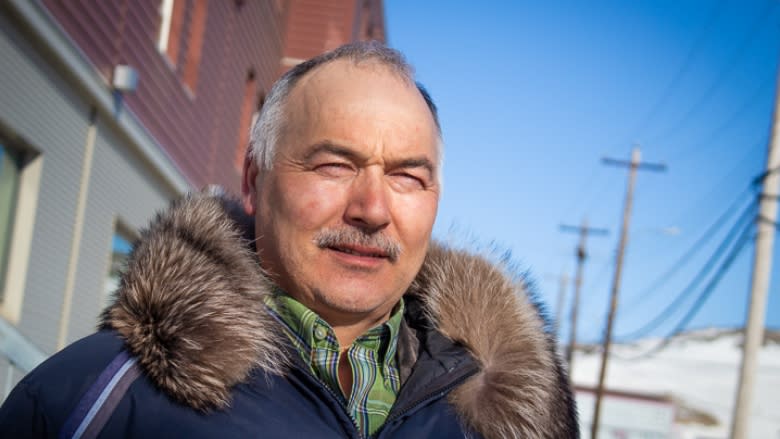Inuit worry about toxic splash from rocket debris in Canada's Arctic waters
Inuit and politicians in Nunavut are raising concerns that debris from a European rocket being launched today could contain toxic fuel when the space junk falls back to Earth in the High Arctic.
It's the 15th launch of its kind over the past decade potentially affecting Baffin Bay, according to one Canadian researcher tracking the mission.
The rocket, carrying the Sentinel-3B satellite, is expected to blast off from northern Russia to monitor Earth's oceans, land and ice. The rocket is fuelled by hydrazine — an extremely toxic substance — that "only specialists dressed in bulky astronaut-like suits" can be around, according to the European Space Agency's website.
There are even doctors and emergency officials waiting nearby with an ambulance and fire truck in case of any incidents while fuelling the agency's satellite for liftoff.
Joe Savikataaq, Nunavut's minister of environment, says the territory has been powerless to stop the launches. He says there haven't been any studies conducted to find out if the debris splashing down into the water is harmful to wildlife in the region, he says.
"It is a concern for us," said Savikataaq. "No country wants to be a dumping ground for another country's spent rockets."
"We've been told all the toxic fuel is burned off into re-entry into the Earth's atmosphere. But we don't know."
Worries wildlife could be affected
The Nunavut emergency management office is monitoring the situation. According to a public service announcement from the territory's officials, the falling debris may land in open waters between Ellesmere Island and Greenland.
"It is expected that the debris will fall outside of Canadian territorial waters and is considered a very low risk event," reads the notice. "There should be no harmful effects to any community, the environment or animals near the impact area."
Okalik Eegeesiak, chair of the Inuit Circumpolar Council and the Pikialasorsuaq Commission, says until research proves it's safe, the launches should be stopped.
The space junk is falling in one of the most biodiverse areas in the Arctic, she said.
The North Water Polynya (stretch of open water) is outside of Canada's territorial waters but inside an economic zone that the country partially controls. It's home to seal, beluga, narwhal and walrus, which Inuit from Canada and Greenland hunt and rely on for food.
"I'm very concerned and frustrated that this is happening once again," said Eegeesiak. "The government is ignoring Inuit concerns about our food sources being potentially contaminated by these hazardous materials."
Eegeesiak worries about the cumulative effects of the debris that's been falling into the water and sinking for years. She wants the Canadian government to include Inuit in the work to monitor and manage the Arctic.
Debris could be size of a minivan
Michael Byers, professor of international politics and Canada research chair at the University of British Columbia, says the risk is low, but people in the region should still be cautious and stay indoors for 24 hours from launch time, which is 1:57 p.m. ET.
The rocket is as big as a 15-storey building and is a re-purposed intercontinental ballistic missile from the Cold War that comes from Russia. That second stage, the chunk that breaks off and could head toward the High Arctic, is about the size of a minivan.
"It is likely that some of this highly toxic fuel will remain in the second stage of the rocket as it comes back to Earth," said Byers, who is tracking the launches. "That fuel might make it to the surface or it might escape if the fuel tank ruptures and turn into a cloud of toxic vapour that might then drip down over Greenland or Canada's Ellesmere Island."
Byers says there is research out of Russia and Kazakhstan that suggests the impacts are serious. However, there has not been any research conducted on the impact of the debris in Canada.
Savikataaq says it's a challenging issue to study since the debris is likely to fall in the water and sink. The area is vast and it would be difficult to track and retrieve the rocket debris.
Push to shift to green propellants
The European Space Agency responsible for the satellite launch told CBC News that it's working on switching over to propellants that are harmless to the environment.
"Green chemical propellants are also under development to replace hydrazine, but these are not operational yet," wrote the ESA in a statement. "A green propellant, for in-orbit manoeuvring could be H2O2 (hydrogen peroxide) or LMP-103S being developed by Bradford/ECAPS under ESA funding. Hydrogen peroxide could be used for both satellites and launchers, and here developments are ongoing at Nammo (Norway)."
The European Union introduced a regulation in 2007 to remove the use of environmentally dangerous chemical substances. However, it is still used under specific conditions in very small amounts for space applications until there are alternative technologies.
The government of Nunavut says it's unlikely, but if wreckage does fall on the land, the territory's emergency management office will tell the public and try to recover the debris.
In an email to CBC News, a spokesperson with Public Safety Canada said the federal government is closely monitoring the rocket launch and debris, which is expected to land in the sea near Ellesmere Island.
"As debris is not anticipated to land on Canadian soil, the risk to the public, health, and the environment is extremely low," said Andrew Gowing.
Gowing said Russia gave Canada advance notice of the rocket launch, something Canada has stressed a need for so safety and security precautions, as well as environmental concerns, can be addressed.
Correction : A previous version of this story stated that the Sentinel-3B is the rocket. In fact, it is the satellite.(Apr 26, 2018 12:16 PM)



